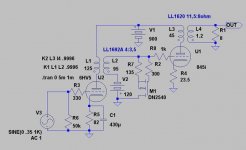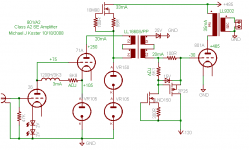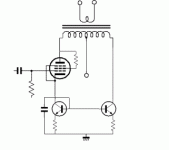Kevin,
Yes, with the 211 the voltage gain and swing since to be ok
Using the 845:
Ri=1700 u=5.3
with 11K5 (LL1620 con.B) we have Rout=1700/(38*38)=1.2ohm good to drive any loudspeakers
to get 10Vrms on 8ohm (Pout=10*10/8=13w) you need Vg=10*38/5.3=72v
Using the 211:
Ri=3800 u=12
with 11K5 (LL1620 con.B) we have Rout=3800/(38*38)=2.6 too high to drive normal loudspeakers
with 23K(LL9202 con.B) we have Rout=3800/(53*53)=1.35ohm
to get 10Vrms on 8ohm (Pout=10*10/8=13w) you need Vg=10*53/12=44v
but the 211 at 530Vrms on anode will be linear like the 845 at 380Vrms ?
Probably it is true using the 211 and 23K transf. at higher plate voltage near 1200v
With a 23K the bias current necessary is low so only 60mA will be enougth
So is true that the 211 give less problem as input swing but it need higher power supply voltage to get same power and this mean more difficult to find good components with 1500Vdc like the capacitors.
For a more precisious calculation add internal resistance of transformers (prim. and sec.).
Yes, with the 211 the voltage gain and swing since to be ok
Using the 845:
Ri=1700 u=5.3
with 11K5 (LL1620 con.B) we have Rout=1700/(38*38)=1.2ohm good to drive any loudspeakers
to get 10Vrms on 8ohm (Pout=10*10/8=13w) you need Vg=10*38/5.3=72v
Using the 211:
Ri=3800 u=12
with 11K5 (LL1620 con.B) we have Rout=3800/(38*38)=2.6 too high to drive normal loudspeakers
with 23K(LL9202 con.B) we have Rout=3800/(53*53)=1.35ohm
to get 10Vrms on 8ohm (Pout=10*10/8=13w) you need Vg=10*53/12=44v
but the 211 at 530Vrms on anode will be linear like the 845 at 380Vrms ?
Probably it is true using the 211 and 23K transf. at higher plate voltage near 1200v
With a 23K the bias current necessary is low so only 60mA will be enougth
So is true that the 211 give less problem as input swing but it need higher power supply voltage to get same power and this mean more difficult to find good components with 1500Vdc like the capacitors.
For a more precisious calculation add internal resistance of transformers (prim. and sec.).
Hi,
Maybe this is a little far out, but why not make a Lundahl transformer coping with more current by adding an opposite current through the secondary? This to get rid of the capacitor and still get enough inductance. If 4:3,5 doesn´t give enough gain, one could go 3,5:4.
Maybe this is a little far out, but why not make a Lundahl transformer coping with more current by adding an opposite current through the secondary? This to get rid of the capacitor and still get enough inductance. If 4:3,5 doesn´t give enough gain, one could go 3,5:4.
Attachments
audiodesign said:Kevin,
Yes, with the 211 the voltage gain and swing since to be ok
Using the 845:
Ri=1700 u=5.3
with 11K5 (LL1620 con.B) we have Rout=1700/(38*38)=1.2ohm good to drive any loudspeakers
to get 10Vrms on 8ohm (Pout=10*10/8=13w) you need Vg=10*38/5.3=72v
Using the 211:
Ri=3800 u=12
with 11K5 (LL1620 con.B) we have Rout=3800/(38*38)=2.6 too high to drive normal loudspeakers
with 23K(LL9202 con.B) we have Rout=3800/(53*53)=1.35ohm
to get 10Vrms on 8ohm (Pout=10*10/8=13w) you need Vg=10*53/12=44v
but the 211 at 530Vrms on anode will be linear like the 845 at 380Vrms ?
Probably it is true using the 211 and 23K transf. at higher plate voltage near 1200v
With a 23K the bias current necessary is low so only 60mA will be enougth
So is true that the 211 give less problem as input swing but it need higher power supply voltage to get same power and this mean more difficult to find good components with 1500Vdc like the capacitors.
For a more precisious calculation add internal resistance of transformers (prim. and sec.).
Good analysis, and I actually need the higher source impedance because of the way my speakers were designed.. Will probably run something like 12K opts.
Hi Andrea,
as I mentioned you, the best result I got is with 6H30, parallel ( are easy to select for similar sections), with a Tango NC20 interstage at 20 mA of Ia; the swing is 185 Vrms/530 Vpp ( at less than 2% of distortion.
The Va is about 250 Vdc. I am close to the limit but the tube is really strong.
Another tests
http://www.multitask.it/845/1403-1Khz-20mA-15vin-nc20.jpg
at this addres there is a FFt with 6BX7 and NC20 (another test) with 20mA at 1KHz, 3% THD; Vout about 130 vrms. at 20 hz the result is good.
http://www.multitask.it/845/1403-1Khz-50mA-nc20.jpg
at this link there is a FFT with the same setting but with 50mA of Ia; the 3% of THD is at 150 Vrm at 1KHz, but at 20 hz it is very bad.
http://www.multitask.it/845/1403-1Khz-20mA-5vin-nc20.jpg
athis link is the same circuit with 20mA of Ia , 5 Vin, 40 Vout, 1 KHz; the IIIrd is low.
Bye
Walter
as I mentioned you, the best result I got is with 6H30, parallel ( are easy to select for similar sections), with a Tango NC20 interstage at 20 mA of Ia; the swing is 185 Vrms/530 Vpp ( at less than 2% of distortion.
The Va is about 250 Vdc. I am close to the limit but the tube is really strong.
Another tests
http://www.multitask.it/845/1403-1Khz-20mA-15vin-nc20.jpg
at this addres there is a FFt with 6BX7 and NC20 (another test) with 20mA at 1KHz, 3% THD; Vout about 130 vrms. at 20 hz the result is good.
http://www.multitask.it/845/1403-1Khz-50mA-nc20.jpg
at this link there is a FFT with the same setting but with 50mA of Ia; the 3% of THD is at 150 Vrm at 1KHz, but at 20 hz it is very bad.
http://www.multitask.it/845/1403-1Khz-20mA-5vin-nc20.jpg
athis link is the same circuit with 20mA of Ia , 5 Vin, 40 Vout, 1 KHz; the IIIrd is low.
Bye
Walter
Andrea,
if you use the Sowter 8540, 1:4; loaded with 50k you have 3K of input impedance; this will help.
This means that with a G of 8 with 6H30 ( I have to check on my notes), with a Vin 2 volt (normally output for a preamp) we have 8 volt on input of 6H30 and 64 volt at the ouput of this stage.
Bye
Walter
if you use the Sowter 8540, 1:4; loaded with 50k you have 3K of input impedance; this will help.
This means that with a G of 8 with 6H30 ( I have to check on my notes), with a Vin 2 volt (normally output for a preamp) we have 8 volt on input of 6H30 and 64 volt at the ouput of this stage.
Bye
Walter
audiodesign said:Using the 6HV5A is very difficult use interstage transformers because these need an inductance value about 100H and 25-30ma of dc current
Something like this or what Lars suggests will allow you to use a tiny
gap interstage transformer like the LL1660S/PP that has 290H Lpri.
The current imbalance will only be a couple of mA.
for your pentode you will need to add a load resistor somewhere
instead of or addition to the "CC gyrato" or CCS.
Cheers,
Michael
Attachments
Hi Andrea,
Probably you didn´t read my post carefully as you did this comment. Reread please! With a compensation current you can go well above 30mA with the 18mA Lundahl with 125H primary.
Michael Koster, from whom I partly borrowed the solution, proposed about the same thing(but with PP transformer) just above.
Using the 6HV5A is very difficult use interstage transformers because these need an inductance value about 100H and 25-30ma of dc current
Probably you didn´t read my post carefully as you did this comment. Reread please! With a compensation current you can go well above 30mA with the 18mA Lundahl with 125H primary.
Michael Koster, from whom I partly borrowed the solution, proposed about the same thing(but with PP transformer) just above.
I would like to make a summary here of these two days.
The project born with the idea of a two stage single ended amplifier with 845.
In my idea this amplifier should be driven by vacuum tube pre-phono and CD player without active pre-ampl.
It is obvious that an input step-up transformer 1:4 or 1:8 resolv many problems of voltage gain but in this case the amplifier must be driven by very low output impedance like 300-600ohm because the gate input capacity is multiplied two time for the turns ratio.
Use an interstage transformer with turn ratio 1:4 is not possible because it mean drive the 845 with very few current and high Rout.
Excluding the input transf. to drive the 845 we need a vacuum tube with:
1) very high voltage gain (u)
2) the lowest internal resistance
3) bias current about 20-50mA
4) voltage swing no less than 100Vrms
The 6HV5A is a valid choice but this work with low distortion only at min. 900v so it is obvious that resitance load is not possible because this mean use power supply voltage very high near 2000v.
A valid load is a choke or an interstage transformer.
The internal resistance near to need to 3500-4500ohm need a choke or single ended transf. with an inductance value no less than 100H.
Flow(-3db) = R / (2 * 3.14 * L) = 4600 / (2 * 3.14 * 100) = 7Hz
It is difficult to find an interstage transf. with 100H so the choke is a simple way to resolv the problem.
There are some method to use push pull interstage transf. with higher inductance (because there is no gap) and these can be interesting but a little bit complex.
I would like to exclude any hybrid solution to be a pure vacuum tube amplifier.
The main problem using the choke is the interstage capacitor that infuence the sonic performances. Actually I am using MKP caps. because is not possible find Jensen copper film paper in oil with 2.2uF 1200v.
Kevin have suggested to use the 211 instead of 845 because it have more voltage gain 12 instead of 5.3.
But with 211 it is necessary use an output transformer with higher turn ratio to get the same good damping factor on normal loudspeakers so the grid voltage necessary is near.
In many case a 23K output transf. is more expensive of a 10-11K.
Tell me if I have forgot something.
The project born with the idea of a two stage single ended amplifier with 845.
In my idea this amplifier should be driven by vacuum tube pre-phono and CD player without active pre-ampl.
It is obvious that an input step-up transformer 1:4 or 1:8 resolv many problems of voltage gain but in this case the amplifier must be driven by very low output impedance like 300-600ohm because the gate input capacity is multiplied two time for the turns ratio.
Use an interstage transformer with turn ratio 1:4 is not possible because it mean drive the 845 with very few current and high Rout.
Excluding the input transf. to drive the 845 we need a vacuum tube with:
1) very high voltage gain (u)
2) the lowest internal resistance
3) bias current about 20-50mA
4) voltage swing no less than 100Vrms
The 6HV5A is a valid choice but this work with low distortion only at min. 900v so it is obvious that resitance load is not possible because this mean use power supply voltage very high near 2000v.
A valid load is a choke or an interstage transformer.
The internal resistance near to need to 3500-4500ohm need a choke or single ended transf. with an inductance value no less than 100H.
Flow(-3db) = R / (2 * 3.14 * L) = 4600 / (2 * 3.14 * 100) = 7Hz
It is difficult to find an interstage transf. with 100H so the choke is a simple way to resolv the problem.
There are some method to use push pull interstage transf. with higher inductance (because there is no gap) and these can be interesting but a little bit complex.
I would like to exclude any hybrid solution to be a pure vacuum tube amplifier.
The main problem using the choke is the interstage capacitor that infuence the sonic performances. Actually I am using MKP caps. because is not possible find Jensen copper film paper in oil with 2.2uF 1200v.
Kevin have suggested to use the 211 instead of 845 because it have more voltage gain 12 instead of 5.3.
But with 211 it is necessary use an output transformer with higher turn ratio to get the same good damping factor on normal loudspeakers so the grid voltage necessary is near.
In many case a 23K output transf. is more expensive of a 10-11K.
Tell me if I have forgot something.
What I think is in common with Lars' and my approach is using a CCS
on the secondary of the OPT to DC-balance the primary current, at the
same time providing a high AC impedance on the grid end of the
interstage transformer secondary. The grid bias is set by the DC
reference on the other end of the IT secondary.
Michael
PS I posted at the same time you did... Pure tube is a nice way to go.
Parafeed with a choke has some fewer issues than the IT.
on the secondary of the OPT to DC-balance the primary current, at the
same time providing a high AC impedance on the grid end of the
interstage transformer secondary. The grid bias is set by the DC
reference on the other end of the IT secondary.
Michael
PS I posted at the same time you did... Pure tube is a nice way to go.
Parafeed with a choke has some fewer issues than the IT.
About the use of PP transformer with no gap we must consider that:
SE OPTs largely avoid the hysteresis effect from maintaining magnetization in a linear region
from:
http://homepage.mac.com/tlinespeakers/vaughn/downloads/SE-v-PP-Part2.pdf
SE OPTs largely avoid the hysteresis effect from maintaining magnetization in a linear region
from:
http://homepage.mac.com/tlinespeakers/vaughn/downloads/SE-v-PP-Part2.pdf
- Home
- Amplifiers
- Tubes / Valves
- Hi-end 845 with only two stage


